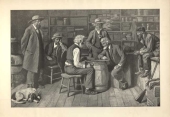The Checker Maven
The World's Most Widely Read Checkers and Draughts Publication
Bob Newell, Editor-in-Chief
Published every Saturday morning in Honolulu, Hawai`i
Noticing missing images? An explanation is here.
A Grand Rapids Speedster

Today's problem has quite a history. It's credited to an American, a Mr. O. H. Richmond of Grand Rapids, Michigan, but it was actually published in Glasgow, Scotland, some time in the 1880s. Grand Rapids in the 1880s was a town of less than 60,000, mostly known for its production of fine furniture. In the world of checkers as well, it apparently had international reach.
And now, something like 125 years later, we too can enjoy this excellent problem. We're presenting it as a speed problem (what else would we do with a problem from Grand "Rapids"), but we must say that it pushes the limit for speed solving. For this reason, we'll allow 30 seconds for the solution. Our guess is that you'll either see it right away, or you won't. We rate the problem as medium to hard in difficulty; medium if you take your time, and hard if you try to stay within the 30 second time limit.
When you're ready, click on the link below to show the problem and start the clock. When you're finished, come back and click on Read More to see the startling solution.
June Speed Problem (medium to hard, 30 seconds)
![]()
Subtle

An image such as the one above, unusual though it may seem, is filled with deep and and often subtle symbolism and meaning, unraveled only through careful consideration and study.
Today's entry in our Checker School series demonstrates once more that checkers too can be deep and subtle, with each move having its own meaning and significance. The problem shown below, first published over 140 years ago, is definitely not easy, but by any measure it is rewarding, satisfying, and entertaining, and we might even say, enlightening.
BLACK
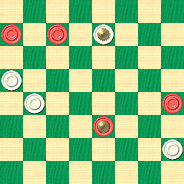
WHITE
White to Play and Draw
W:W28,17,13,K7:BK23,20,6,5.
Can you unravel the subtleties of this difficult position? Think deeply, and be careful of seemingly small nuances that loom large in the end. When you've unraveled the meaning of the problem, click on Read More to see the solution, sample games, and detailed explanatory notes.![]()
Checker Apps for Android

A few weeks back, we presented Ed Gilbert's review of checker apps for the iPhone. We promised a similar review of Android apps, and we're bringing you that review today.
The iPhone scene was frankly pretty bleak. Ed didn't find a single truly serious checker app for the popular Apple smartphone. We'll cut to the chase: for Android phones, the situation is somewhat better. There are two reasonable candidates for the "serious app" title and a whole host of "toy" apps.
As was the case with the iPhone, there is just too much detail for a single weekly column, so instead you'll find the full details on this separate web page.
The two apps that we think merit consideration are Checkers Tutor, by world class checker programmer Martin Fierz (author of CheckerBoard and the Cake computer engine), and Checkers for Android by programmer Aart Bik, who is best known for Chess for Android. Aart's checker app is free and Martin's app sells for just one dollar.


Martin Fierz and Aart Bik
Interesting and detailed email interviews with both Martin and Aart can be found on the web page linked above.

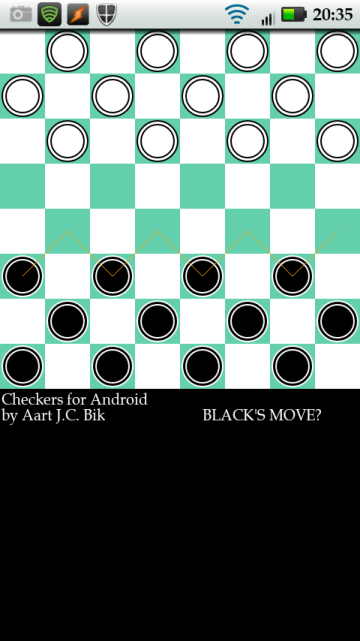
So, which app should you install? Checkers Tutor plays a reasonable game, certainly well above the casual skill level. The same can be said of Checkers for Android. It's also safe to say that neither of these will provide a serious challenge to a master-level player.
Our usual benchmark is Martin Fierz's Simple Checkers engine. Both Checkers Tutor and Checkers for Android play somewhat better than Simple, at least based on the limited trial matchups conducted in our offices. But you won't get play at the level of Cake or KingsRow, either.
There's some irony here. Both Martin and Aart received a lot of user feedback saying that the engines are too strong and that the user can never win a game! This perhaps says more about the casual player than it does about the strength of the computer engines.
How do Checkers Tutor (CT) and Checkers for Android (CFA) compare with each other?
CT has hands-down the better graphics and display, and some additional play features, such as move take-back and replay, neither of which are present in CFA. Both programs lack a move list or a means of exporting moves. CT has optional square numbers; CFA allows compulsory jumping to be turned off, which you may consider a feature or an anti-feature, but Aart says users demanded it. CT allows for selection of a random 3-move ballot. CFA has a tiny endgame database which most notably will allow it to convert a two kings vs. one win, something a surprising number of programs can't do.
Neither app allows for position set-up, but neither engine is really strong enough to do meaningful analysis.
Which engine plays better checkers? That's a good question. We think CT has a definite edge, albeit not a large one. In the two head-to-head matches that we conducted, CT handily won one of them. CFA got a winning position in the other game but then couldn't figure out the ending and the result was a draw. Such limited testing is hardly decisive, of course.
Our bottom line is that there's little reason not to install both apps and make your own comparison. It will only cost you a dollar, after all, and you'll have a lot of fun ahead of you.
Several of the test games are on the companion page mentioned earlier. What we'll show you here is an excerpt from one of the games between CT and CFA. We'll stop at one of the game's critical points and let you take over.
The game was played on April 18, 2012 at the Hawai`i State Library. Checkers Tutor had Black and played at 15 seconds per move. Checkers for Android had White and played at 10 seconds per move (it wasn't possible to set the same timing for both).
| 1. | 11-15 | 23-19 |
| 2. | 8-11 | 26-23 |
An inferior move; 22-17 or 22-28 are better.
| 3. | 9-14 |
4-8 holds the edge.
| 3. | ... | 22-18 |
A checker subtlety: 22-17 equalizes, while this does not.
| 4. | 15x22 | 25x9 |
| 5. | 5x14 | 29-25 |
| 6. | 11-15 |
4-8 would have maintained the lead.
| 6. | ... | 25-22 |
| 7. | 14-18 | 23x14 |
| 8. | 10x26 | 19x10 |
| 9. | 6x15 | 31x22 |
| 10. | 4-8 | 27-23 |
| 11. | 2-6 | 21-17 |
| 12. | 7-10 | 23-18 |
| 13. | 8-11 | 17-13 |
This move loses; 30-26 is correct. CT now has a win on the board but won't find it. Will you?

BLACK (CT)
Black to Play and Win
B:W32,30,28,24,22,18,13:B15,12,11,10,6,3,1.
Who's better, CT, CFA, or you? Match wits with the computer, then click on Read More to see the solution.![]()
The Great Lewis Stroke

Golfer Stacy Lewis is executing quite a powerful and accurate stroke in the photo above, something that takes skill, strength, and timing.
Today's excerpt from Willie Ryan's Tricks, Traps & Shots of the Checkerboard brings us a similar example from the game of checkers. Attributed to the late Lawrence Lewis, skill, strength, and timing are all part of the picture here too. Now, we doubt that checkerist Lewis and golfer Lewis are in any way related, but we don't know if golfer Lewis plays checkers or for that matter if checkerist Lewis played golf. What we do know is that you'll certainly enjoy today's problem. Let's let Willie tell us more.
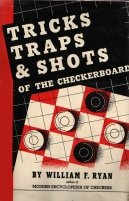
| 9-13 | 15-18---A | 13-17 |
| 22-17 | 29-25---B, 1 | 19-15 |
| 13-22 | 6-9 | 1-6 |
| 25-18 | 24-19 | 24-20---2 |
| 10-15 | 9-13 | 12-16---E |
| 18-14 | 28-24 | Now look at the |
| diagram. |

WHITE
White to Play and Win
W:W14,15,20,21,23,25,26,27,30,31,32:B2,3,4,5,6,7,8,11,16,17,18.
"White now sweeps the board with one of the best concealed strokes recorded in checker literature. It was first shown by the late Lawrence M. Lewis of Wheeling, West Virginia, who sprang it on me in a match at Flint, Michigan, in 1928, throwing the gallery of spectators into an uproar!
A---Tescheleit's Master Play says this move 'leads to a critical draw for black.' The figures featured in this study should disperse that claim.
B---Very weak, as it permits black to work in 6-9, tying up white's single corner development. Tescheleit prescribes 21-17 as the potent element in white's formation, but black has an equal game against it, as follows: 21-17, 11-15*---C, 29-25, 8-11, 17-13, 11-16*---D, 24-20 (if white adopts 24-19, 15-24, 28-19, then 6-10* puts black on the right track), 16-19, 23-16, 12-19, 27-23, 18-27, 32-16, 15-19* (a one-move redeemer), 16-11 (31-27, 4-8, 27-24, 8-12, 24-15, 12-19, 15-11, 7-16, 20-11, 6-9, ends in a draw), 7-16, 20-11, 3-7, 31-27, 7-16, and white has nothing to play for but a draw.
C---Given to lose by Tescheleit, but it is probably the only move to draw! Tescheleit shows 11-16 to draw, then 29-25, 16-20, 26-22, 12-16, 22-15, 7-10, 14-7, 3-26, 30-23, 5-9; now, instead of 17-14 as given in Master Play, 25-22, 8-12, 23-18. Now black hasn't a leg to stand on, and white wins.
D---Corrects and improves Tescheleit's Master Play, where 4-8 is played, white winning with: 25-21, 6-10, 23-19, 10-17, 21-14, etc. Recommended move seems to promote the draw without any real difficulty, indicating that the 15-18 move at A is no lame duck when properly managed in the structural stage.
E---Fatal. The guileless player would never suspect that a paralyzing coup was in the offing. Neither did I! The correct moves to a draw here are: 6-9, 26-22*, 17-26, 31-22, 12-16---F, 30-26*, 9-13---G, 15-10*, 11-15, 20-11, 7-16, 10-6*, 2-9, 14-10, 9-14, 10-6, 8-12---3, 6-2, 16-20, 2-6, 3-8 (if 12-16 is moved, the shot by 21-17 gains the draw), 6-10, 8-11, 10-19, 11-16, 22-15, 14-18, 23-14, 16-30, 14-10. Wm. F. Ryan.
F---If 9-13 is played, then follow with 23-19 for an easy draw; if 2-6 is played, then 14-10, 7-14, 22-17 will win.
G---Or 16-19, 23-16, 8-12, 15-8, 12-19, 22-15, 4-18, 14-10, 7-14, 27-23, 18-27, 32-16, 14-17, 21-14, 9-18, 16-11, 5-9, 20-16, 9-13, 25-21. Wm. F.Ryan."
1---24-19 was certainly better, though the computer doesn't agree that White has more than a small advantage---Ed.
2---Very poor, probably losing for White; 23-19 would have maintained the balance---Ed.
3---This gives up the Black advantage. Willie missed this Black win: 8-11 6-2 16-20 32-28 4-8 2-6 8-12 6-10 3-8 10x17 12-16 23x14 15-18 22x15 13x29 15-10 8-12 21-17 29-25 17-13 25-30 26-22 16-19 10-6 11-16 and now white has no defense against the coming 19-24. Black Wins---Ed.
You'll have to uncover some pretty spectacular moves to solve this one, but take a swing at it and try to drive to the solution. When you're done, click your mouse on Read More to see strength, power, and timing in action.![]()
The Big Dipper

You'll know why we chose the name "Big Dipper" for today's speed problem when you see the diagram, and you won't have much trouble with it, as it's one of the easiest speed problems we've published in quite some time. In fact, it's easy enough that we had planned to only give you five seconds to solve it, but hey, we're generous, and we went with a full ten seconds instead!
Click on the link below to show the problem and start the timer. When you're done, come back and click on Read More to see the solution.
May Speed Problem (Very easy; 10 seconds)
![]()
The Four Kings: Kings At Play
A Special Mid-Week Checker Maven Edition
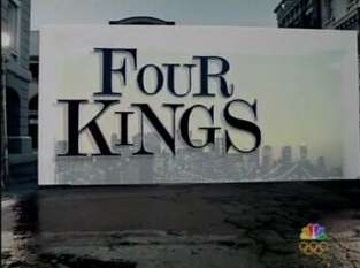
Four Kings was a 2006 television program shown on the NBC network. It apparently didn't attract enough viewers and was cancelled after just seven airings.
Mr. Bill Salot, whose work and efforts were featured in a recent Checker Maven column, has a different take on the idea of Four Kings, and Mr. Salot's checker conception is the kind of happy success that television couldn't manage. His fourth problem composition contest, bigger and better than ever, is titled Kings at Play, as each problem has at least Four Kings on the board.
We're presenting the problems below just to give you an idea of how the competitions have grown and thrived, but we won't give you the solutions; those are found on the Contest Page. While you're there, be sure to cast your vote for the problem you like best. Polls close on Sunday, May 27, 2012.
BLACK

WHITE
White to Play and Win
W:WK4,7,10,11,K17,18,19,20,22,30:B1,8,9,K12,K14,15,21,23,24,K26.
April Fools
BLACK
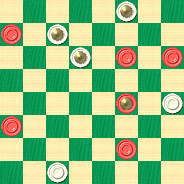
WHITE
White to Play and Win
W:WK3,K6,K10,20,30:B5,11,12,K19,21,27.
Escaped Prisoner
BLACK
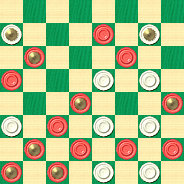
WHITE
White to Play and Win
W:WK5,K8,15,16,21,23,24,31,32:B7,K9,11,13,K18,K20,22,K25,26,27,28,K29,K30.
Multiple Choices
BLACK

WHITE
White to Play and Win
W:WK2,K3,K5,K17,K20,22:BK10,K11,K12,13,K25,K26.
Zonk
BLACK
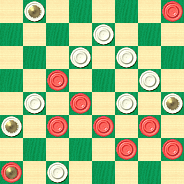
WHITE
Black to Play, White to Win
B:WK1,7,10,11,16,17,19,K20,K21,30:B4,14,18,22,23,24,27,28,K29.
Mr. Salot also tells us "... please enter your original, unpublished, dual-free problems in future contests by sending them at any time to Bill Salot, 1006 Elmwood Drive, Colonial Heights, VA 23834-2905, or wjsalot@comcast.net. Try your hand at any size or style, corrections of published play, game positions, sight solvers, stingers, strokes, novelties, strategies, whatever strikes your fancy."
The Checker Maven is both proud and delighted to support Mr. Salot's efforts.![]()
Our Northern Neighbor

The famed checker editor Manson D. Teetzel, whose career spanned decades of checker publishing, originally came from the town of West Lorne, in Elgin County, Ontario, Canada. No doubt "Teetzel" as he simply liked to call himself, would have been familiar with a scene similar to the one shown above, a beautiful photo of the Canadian shores of Lake Erie, not far from Mr. Teetzel's home town. (The photo is presented courtesy of photographer Rick Blaxall; more of Mr. Blaxall's work can be seen here.)
Teetzel later moved to the United States, where he published American Checker Monthly and for which he is probably best known. But while still in Ontario, he produced The Canadian Checker Player, and it's a problem from the latter journal that we present today. Teetzel didn't give an attribution for the problem; he simply set it forth, something over a century ago.
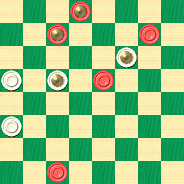
BLACK
Black to Play and Win
B:WK22,20,K19,12:BK31,K27,25,18,3.
Black is a man up, but that's about to change as White is going to even the tally on his next move. Yet Black can still win. Can you figure out how? You don't have to be Canadian to find the solution, you just have to be a Checker Player. Give it a try and then click on Read More to see the solution.![]()
Our Reasoning Powers
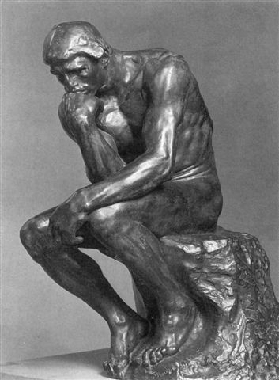
Certainly, the game of checkers is a great exercise of our thinking abilities and a terrific way to develop our reasoning powers. The problem shown below, based on a game played by 19th century checkerist J. P. Reed, will definitely stretch and grow your thinking and reasoning skills. It's this month's entry in our ongoing Checker School series, and comes from Ben Boland's classic work, Famous Positions in the Game of Checkers.
WHITE
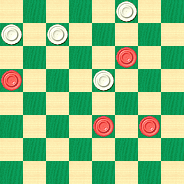
BLACK
Black to Play and Draw
B:W30,28,27,18:B22,20,10,9.
Black has a severely limited choice of moves, always a sign of trouble. Yet the position can be drawn, although that will require quite an application of our reasoning powers. Can you reason it out? Think it through, and then click on Read More to see the solution, a sample game, explanatory notes, and a special insert on reasoning powers in checkers.![]()
Sullivan's Catch
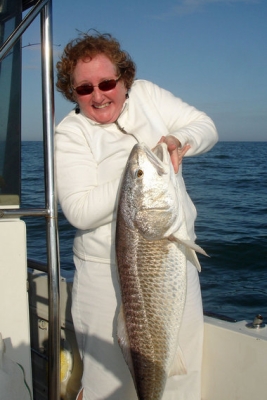
We're not certain that the happy lady shown above is named "Sullivan" --- though that's entirely possible --- but we're most sure that she's made quite a catch indeed, and we can appreciate why she's smiling so broadly.
Of course, the real question for us should be, "Does she play checkers?" and although that's another thing we can't know for sure, it's definitely within the realm of possibility.
Today's column, though, is about a different Sullivan and a different kind of catch, one that is just as tasty as the catch shown above. It comes from Willie Ryan's Tricks Traps and Shots of the Checkerboard, and Willie will tell us about it in his own words.

"When something new is found on an ancient opening like the Ayrshire Lassie, that's news. A few years ago, James Sullivan, a strong amateur from St. Louis, Missouri, hatched a new twist on the Ayrshire Lassie by 21-17 at the fourteenth move of the game below. He subsequently sprung it on Newell Banks and me, and, like two babes in the woods, we both fell for the sucker bait by 9-13 in reply. This trap is a 'natural,' and will catch even experienced players.
| 11-15 | 15-18---A | 11-18 |
| 24-20 | 22-15 | 21-17---1 |
| 8-11 | 11-18 | 9-13---B, 2, which |
| 28-24 | 26-22 | leads to the |
| 4-8 | 7-11 | diagrammed |
| 23-19 | 22-15 | placements. |
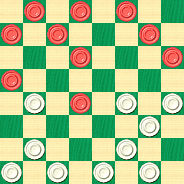
WHITE
White to Play, Black to Draw
W:W32,31,30,29,27,25,24,20,19,17:B18,13,12,10,8,6,5,3,2,1.
A---If you want a short, fast game, play 9-13. Your opponent, no doubt, will reply 20-16, 11-20, 22-17, 13-22, 25-4, winning fast and leaving you short.
B---Newell Banks and Author Ryan slept here! Of course, the trap that follows this move is best avoided, but 9-13 does not lose, as erroneously claimed by Sullivan. The safest course for black at B is: 18-23---2, 27-18, 9-14, 18-9, 5-21, 32-28,10-15,19-10, 6-15, 31-27, 8-11, 27-23, 1-6, 25-22, 3-7, 23-19, 6-10, 22-18, 15-22, 19-16, 12-19, 24-8, 10-14, 8-3, 7-10, 3-8, 14-18, 8-11, 18-23, etc., consummating a draw. Wm. F. Ryan."
1---30-26 or 32-28 would be much better here. While not calling this necessarily a loss, the computer deems 21-17 as quite poor, giving Black a solid advantage---Ed.
2---After 9-13, the game indeed evaluates as a draw. After 18-23, as recommended in Note B, the game also evaluates as a probable draw, as Willie demonstrates. However, the computer thinks the correct move is instead 9-14, which preserves Black's substantial advantage, for instance KingsRow gives 9-14 17-13 2-7 31-26 7-11 27-23 18x27 32x23 3-7 25-22 14-18 23x14 10x17 29-25 5-9 19-15 11x18 22x15 9-14 and White is all but lost---Ed.
Now, as you try to resolve this position, we feel it only far to warn you: Just as Willie missed a trick or two at Notes 1 and 2 above, he also misses a trick in his proposed solution. So in one sense, we're asking you to do a little better than Willie; that's quite a demand to make. But this problem is well worth your time. Can you "catch" the solution, or will it be the one that got away? When you're finished, hook your mouse on Read More to see some detailed analysis.![]()
Spring Into Spring When This One Springs
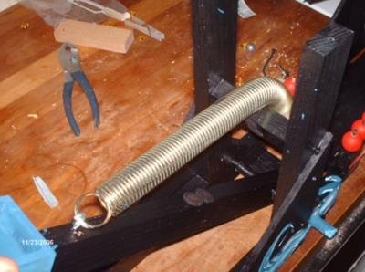
We always hear about "springing into spring" at this time of year, and the arrival of spring is always welcomed after a long winter. Shown above, though, is a spring of a different kind, and when this one springs, we think you'd better move fast and clear the area.
Moving fast and clearing the area--- on the checkerboard--- are our topics for today. We're doing something a little different; we're presenting a stroke problem as a speed problem. Unfair? How can you say such a thing! We're going to give you 60 seconds to solve this one; that's a whole minute!
When you're ready to spring into action, click on the link below--- and move fast. When you're done, spring your mouse on Read More to uncoil the solution.
April Stroke Problem (easy to moderate difficulty; 60 seconds)
![]()
The Checker Maven is produced at editorial offices in Honolulu, Hawai`i, as a completely non-commercial public service from which no profit is obtained or sought. Original material is Copyright © 2004-2025 Avi Gobbler Publishing. Other material is public domain, as attributed, or licensed under Creative Commons. Information presented on this site is offered as-is, at no cost, and bears no express or implied warranty as to accuracy or usability. You agree that you use such information entirely at your own risk. No liabilities of any kind under any legal theory whatsoever are accepted. The Checker Maven is dedicated to the memory of Mr. Bob Newell, Sr.

